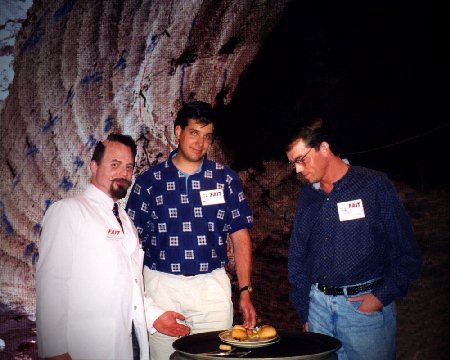Nutritional Research Breakthrough at FAIT!


The innocuous-looking dinner rolls pictured above are actually a high-energy time-released food product developed by FAIT's nutritional experts Swinton and Christensen (pictured above, to the right of Dr. Flaxon). Working closely with our saprophysicists (who have been both cataloging and developing new strains of edible fungi with various physical properties), Swinton and Christensen have hit upon a substance that leaves eaters feeling full (removing hunger pangs) while also providing nutritional value for extended periods of time.
Using a process known as nutritional bombardment, the highly absorbent fungal matter is grown in a nutrient-enriched soil and, upon harvesting, saturated with a blend of vitamins, minerals, amino acids, neuropeptides and other dietary requirements, using a focused molecular beam developed by Christensen.
The new substance's physical properties after cooking combine with its nutritional value to make it an ideal foodstuff for our diligent staff, who often work long days and find it difficult to take breaks for meals. Additionally, the substance solves one particularly nagging problem with regard to our research projects: the feeding of our volunteer test subjects.
While a normal serving provides effects lasting 8 to 10 hours at a time, a special formulation called "Go-Dough" provides nutrition for 2-3 weeks before it breaks down into a liquid state in the system and is eliminated via the normal processes. Go-Dough has allowed FAIT's research staff to increase the long-term immersion period for volunteers by delaying the need for administration of our life-preserving metabolant mixture. It also helps during the initial stages of a session by allowing the subjects to feel "well-fed" at the start of their session and thereby reducing anxiety, which complicates calibration procedures.